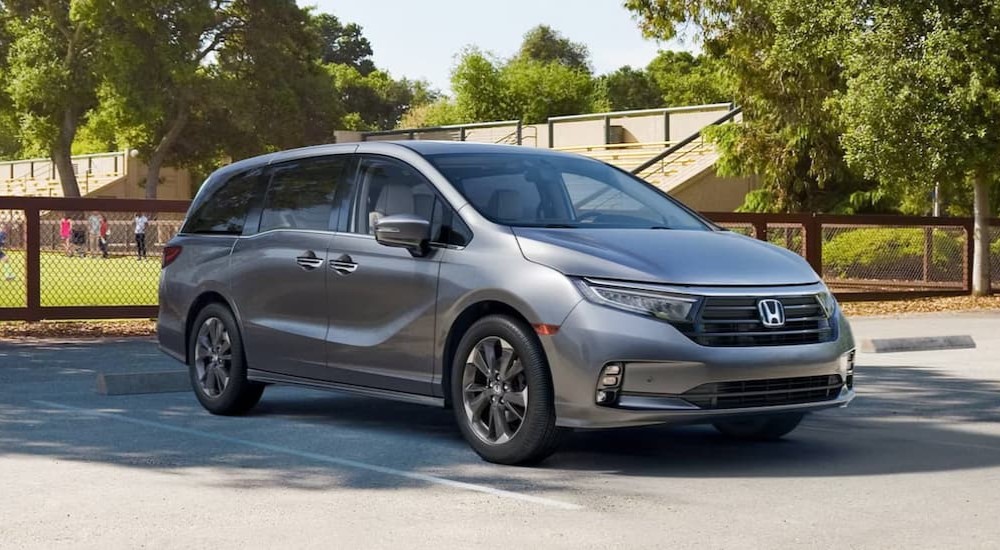It’s 1997, and your mom has begrudgingly agreed to take you and your friends to see the Star Wars Special Edition at your local theater. Do you and six of your buddies all pile into a large SUV? No, absolutely not; Mom’s minivan will be your personal Millennium Falcon. While scenes like these and minivans containing them were once common, SUVs have largely taken over the auto industry while replacing minivans as the top choice for people needing plenty of passenger space.
But if you head to a used Honda dealer, one thing you’ll quickly discover is that the minivan hasn’t completely been driven out of the market like so many womp rats fleeing from skyhoppers down Beggar’s Canyon. No, the Honda Odyssey is not only still available as a new model right now but has remained an option for drivers for nearly 30 years. Let’s take a look at where this legendary model has been and how it survived the arrival of the SUV Empire.
Origins of the Honda Odyssey (1995)
When Honda began developing the original Odyssey, they were doing so on the back end of an economic crisis in Japan. This meant their resources were somewhat more limited than they might have liked, and the Odyssey needed to be developed in a way that utilized existing manufacturing options and materials. The result was a first-generation Honda Odyssey that was surprisingly small for a minivan. This made it a popular option in Japan, but it found less initial success here due to its smaller size and stature—after all, if you’re buying a minivan, you want plenty of room inside to take advantage of.
Despite it being a minivan, the Odyssey was initially based on the Honda Accord platform, which accounts for its smaller size. Powered by a 2.3L I-4 engine, the original Odyssey featured a four-speed automatic transmission and was available in two trim levels: an LX model that offered seating for up to seven people thanks to a three-person middle bench seat or a six-passenger EX model with a pair of seats in the second row instead.
After winning numerous awards in Japan, the Odyssey became Honda’s fastest-selling there, but it lacked something to help it excel here in the US.
The Second-Generation Odyssey (1999)
The “something” that was missing would be found with the second generation of the Odyssey, which launched for the 1999 model year (just in time to kick off a new millennium). This was the generation that firmly cemented the Honda Odyssey as a contender here as it grew in size significantly to deliver what American drivers are looking for in a six or seven-passenger vehicle. Designed primarily with North America in mind, this version of the Odyssey was sold in Japan as the LaGreat.
A new 3.5L V6 engine was introduced for the larger Odyssey, which helped make it more enjoyable to drive and propelled its bulk quite well. The first-generation model had rear doors that swung out like a standard vehicle, but these were replaced with the sliding doors you expect on a minivan for the second generation. Honda had introduced the world to the idea of rear seats that fold down into the floor of a vehicle to disappear completely with the first-generation Odyssey; these “Magic Seats” remained in place for the new model. With a facelift and boost to engine power for the 2002 model year, the second-generation Odyssey won plenty of acclaim and became a favorite option for many drivers looking for a big-family vehicle.
The Odyssey Finishes Its First Decade (2005)
For its tenth anniversary, Honda launched a third generation of the Odyssey with a complete redesign that made it wider. With this model, we can see the Odyssey enter the modern era of vehicles as features like side-curtain airbags and electronic stability control became standard on all models. Other great features like a power moonroof and additional storage inside became available for this generation, while the fold-down rear seats remained and were improved with a 60/40 design rather than being a solid bench.
The 3.5L V6 engine on this model was once again improved and boosted to deliver 255 hp—a far cry from the 130 hp provided by its original I-4 engine. Changes in engineering helped the third-generation Odyssey maintain respectable fuel economy for a vehicle of its size, and numerous trims were available with a variety of interior and exterior features. A facelift for the 2008 model year helped refresh the Odyssey and kept it a favorite of many drivers, ensuring it remained a popular option on American roads.
The Fourth-Generation Odyssey (2011)
Once again redesigned for its fourth generation, the Honda Odyssey launched for the 2011 model year grew in size with a larger body and another increase in width. It grew slightly longer, while the use of high-strength steel in most of its body ensured a strong vehicle that has stood the test of time. Numerous trim levels were released for this new generation, including a Touring and an even more luxurious Touring Elite option, which was offered on the Odyssey for the first time with this one.
A 3.5L V6 engine remained the standard for these new models, with variable cylinder management to boost its overall performance and efficiency. Interior updates included a wide range of advanced tech and luxury features, including an available 12-speaker sound system, a rear entertainment system, and advanced safety systems like a Blind Spot Display. This generation received a facelift for the 2014 model year that made a six-speed automatic transmission standard on all models while updating its exterior styling and introducing more advanced technology. All of these features helped keep the Odyssey modern and in league with popular SUVs that threatened to push it out of the market.
The Odyssey Enters Its Twenties (2018)
For the 2018 model year, just a few years after its twentieth anniversary, Honda released an all-new fifth-generation Odyssey with another redesign. This time, the Odyssey became slightly narrower and taller, with new materials that allowed it to shed about 75 lbs in weight. This was helped by the new ten-speed automatic transmission available for the Odyssey, which weighs less than the previous six-speed option and delivers a smoother driving experience. A 3.5L V6 engine remains standard on the Odyssey, now engineered to deliver 280 hp—more than double the power of the engine in the original model from the 1990s.
The modern Odyssey is a stunner with a sleek design and standard Honda Sensing driver assistance technology that ensures everyone on the road stays safer. An update for 2020 made the ten-speed automatic standard on all models (a nine-speed automatic had been standard), while a facelift for the 2021 model year updated its style again with a redesigned front grille and more details. Inside the current Honda Odyssey, you’ll find a spacious and comfortable interior with seating for up to eight passengers, Magic Slide second-row seats that make it easy to access the third row, and an available 11-speaker premium sound system to ensure everyone inside has a great time on the road.
Does the Odyssey Have What It Takes to Strike Back?
As we approach the thirtieth anniversary of the Odyssey, I wouldn’t be surprised to see Honda launch an all-new and reinvigorated sixth-generation for this classic minivan. Although it’s managed to survive the onslaught of SUV domination over the auto industry, its sales have been lower in recent years, and it has heavy competition from other models like the Chrysler Pacifica.
Personally, I love that Honda has stuck with the Odyssey—sure, they’ve released their fair share of SUVs to deliver what a wide range of drivers are looking for, but they’ve also kept the Odyssey on the road. Since they recently announced their first all-electric SUV in the upcoming Prologue, it will be interesting to see if we get a hybrid or battery-electric version of the Odyssey for its next redesign; only time will tell.




